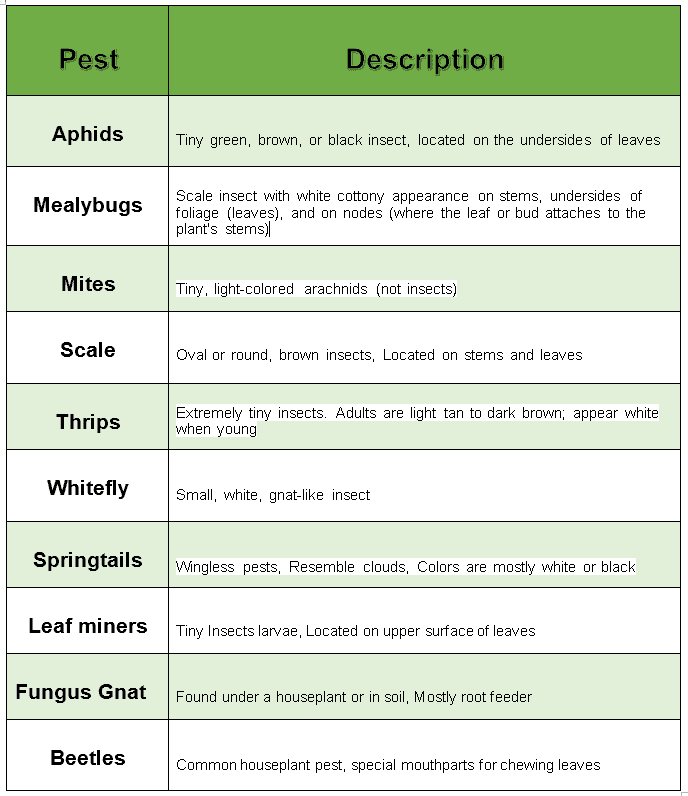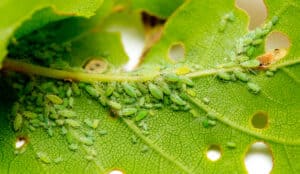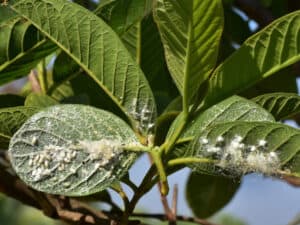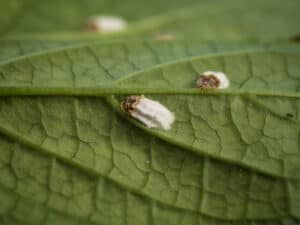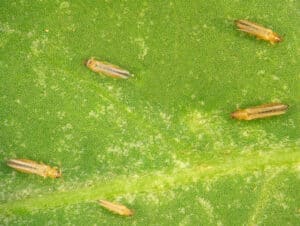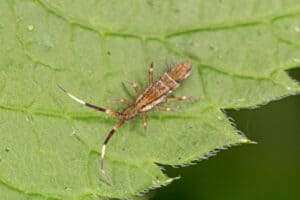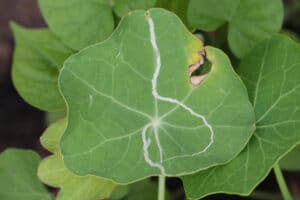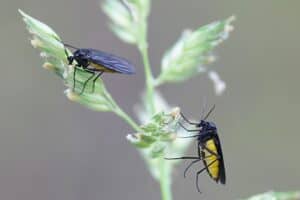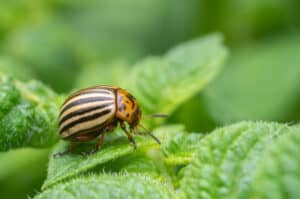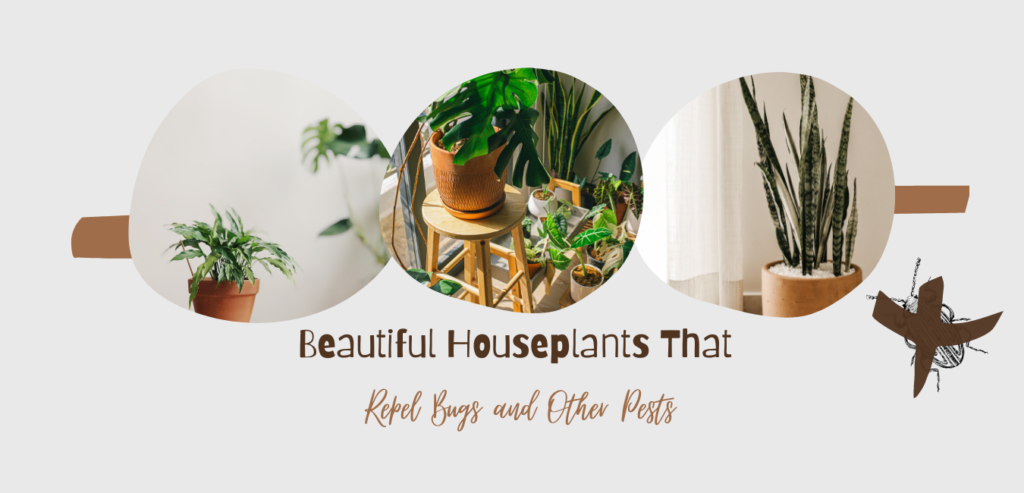HousePlantJoy is supported by our audience. When you purchase through one of our links, we may earn a small affiliate commission. As an Amazon Associate I earn from qualifying purchases. Your cost is not affected.
==================
TYPES OF PESTS ON HOUSEPLANTS
Why worry about types of pests on houseplants? Your houseplants live indoors so they should be safe, right?. Unfortunately. no. Our homes provide the perfect environment year-round for these unwanted villains. In fact, the temperature, ventilation, and humidity levels are ideal for pests. Plant pests that make their way indoors will find them easy prey. Pests have no natural predators internally, so their numbers will quickly grow. Please don’t put off taking care of your houseplants until they’re in trouble. Check the indoor plants for symptoms of insect infestation daily. However, you have the highest chance of saving your houseplants if you catch them early.
This article will discuss different types of pests on houseplants and some ways to prevent them. To learn about other problems and solutions for houseplants, please see: Houseplant Problem Solver.
Plant Pests, Unwelcome Guests
Pests of houseplants are tiny bugs or mites that feed on the plants’ leaves, branches, and roots. A wide variety of insects can infest indoor plants. Some will crawl on the leaves or in the dirt, and others will be able to fly.
They’re just incredibly irritating, regardless of how they move (or don’t move)! Plant pests and diseases disrupt plant growth and cause damage to both cultivated and wild plants. Moreover, Plants are unable to achieve their genetic potential due to the disturbance caused by pests.
Prevention: Your First Line of Defense
It would help if you used various best practices to minimize the risk of pest infestation in your house. They aren’t “no-fail” remedies since certain plant pests will go undetected by the naked eye. However, there are usually excellent and efficient approaches to help keep the plants safe.
1. Carefully Inspect a Plant
Checking for pests is among the most effective ways to keep your houseplants healthy. If your plant is brand new or is moving indoors for the winter, you’ll want to make sure it’s bug-free. Moreover, don’t forget to look under the leaves since this is where bugs like to reside. If you can spot pests, you can inform the plant shop so that the plant can quarantine and sell to no one else.
2. Use a clean plant pot.
If you bring a new plant home and place it in a new container, be sure to disinfect the pot with a diluted soap carefully. Moreover, you can use a bleach solution to make sure no carriers of disease. Moreover, the same goes for mud; always get fresh ground for your houseplant.
3. Keep your plants healthy.
Ensuring the wellbeing of your plants helps to deter pests from going. Weakened plants are more likely than stable plants to get infested. Each plant has its own particular needs, which allows you to take the time to study your plant. Moreover, know how much sunshine and water it deserves.
If they’re not pleased because of their appearance, your plants will let you know. If the plant has dried leaves or wilting, it will likely require more water. Through yellowing or dropping leaves, you can suggest that your plant doesn’t have much light.
4. Isolate your plant
If you want to be extra cautious, separate your plant from your other plants for a few days and check its leaves and stems daily. If all seems to be in order, bring everything into the designated area.
5. Pest-Resistant Plants
And if some plants are vulnerable to insect infestations, others strike back. Certain plants provide inherent pest repellent scents. Using a couple of these plants in your garden will help to preserve your other plants. Marigolds and chives are excellent hindrances to aphids. Basil and mint, for example, are believed to repel a variety of pests. These herbs are excellent additives to your plant collection as well as helping to keep your plants healthy.
*****
Types of Pests on Houseplants
There are many different types of pests on houseplants. However, some of the most familiar houseplant insects discuss below.
1. Aphids
Aphids
Aphids occur as a small orange, white, yellow, or black spots on the leaves, stems, and other plant areas. By sucking on the stems and leaves of plants, they kill them. However, Aphids reproduce so rapidly that they can completely cover a plant in days. Moreover, Aphids prefer new growth and the undersides of leaves for feeding. Aphids excrete a sugary substance called honeydew while they eat, which makes leaves glossy and sticky.
Treatment
A strong blast of water in the tub or frequent sprays of insecticidal soap will quickly destroy aphids. They are rigid, stubborn, and you will need to be persistent in your efforts to rid your houseplants of these pests.
Apply repellent sprays containing hot pepper or garlic.
2. Mites
Spider Mites
Broad mites and are a far less serious pest that can do significant damage to plant growing tips. Mites are too small to see with the naked eye. However, if the tips of your houseplant get stunted, bent or the leaves curl, you might have mites. If the mites are not regulated, the leaves will turn bronze or purple, and the plant will die.
Treatment
You should completely submerge the plant in water; in some situations, a miticide or insecticidal soap should use. To prevent the mites from multiplying, it’s usually best to dispose of the contaminated plant.
3. Mealybugs
Mealy Bugs
It is one of the most common types of pests on houseplants. Mealybugs are tiny, pale insects with a scale-like appearance. Adult females use a white waxy material to coat themselves and their nests, giving them a cottony appearance. They settle in and begin sucking the nutrients from the plants. Mealy bug-infested plants sometimes seem to be dried out, even water it. Mealybugs, including aphids, excrete honeydew, which encourages the growth of sooty mold fungi.
Treatment
Mealybugs are very difficult to eradicate. Cut out the infested branches if you catch the issue early. It would help if you also used a cotton swab covered in rubbing alcohol to wipe the mealybugs.
4. Scales
Thrips
Scales are tiny insects that cling to a plant’s stem and then cover themselves with a stiff, oval-shaped shell. They slowly suck the sap from plants, leaving them too frail to support themselves, similar to mealybugs. Armored scales and soft scales are the two types of scale insects. Scales are unusual-looking insects. Adults have no visible legs and are thin and immobile. Moreover, they live on branches and the undersides of plants, but they can also find on upper surfaces.
Treatment
Scale infestations are challenging to eradicate. Pesticides seldom penetrate their tough outer shells. Moreover, you may be able to get rid of the scales by wiping them off with your nail or a gentle brush.
5. Thrips
Thrips
Another most common types of pests on houseplants are Thrips. These are tiny, slender insects with fringed wings that range in color from yellow to black. They are most often present on leaves and in the spaces between flower petals. Adults are medium tan to dark brown; when young, they look blonde.
They eat leaves, flowers, and even fruits in large groups. They not only weaken and distort plant growth but also transmit disease. Leaves with thrip damage also have a silvery or speckled texture, similar to mite-damaged leaves.
Treatment
Because there are no natural predators inside, certain touch insecticides, such as neem or insecticidal soap, can use. Besides, water rinses the plant with water.
6. Whitefly
Whitefly
When the tiny whiteflies on the underground side of the plants are irritated, they seem to fly in a puff. Plants’ leaves and stalks become weakened and discolored as a result of sweat. Moreover, it also has a powdery white appearance that looks like tiny moths.
The immature stage is around the size of a meter and does not move. It is possible to slacken the infested vine. Whiteflies, like aphids, excrete honeydew, turn the leaves bright and sticky while promoting brownish fungal growth.
Treatment
Whiteflies multiply quickly, but finding them will help you get rid of them. Use yellow sticky traps to attract them, or spray them with fungicide soap or horticultural oil.
7. Springtails
SpringTail
When disturbed, springtails are small wingless insect-like animals that can leap several inches into the air. They all spring upwards together in a cluster, resembling a tiny cloud. They come in a variety of colors, but most are white or black. However, they don’t have wings, but they can run. Overwatering is usually the cause of their appearance.
Treatment
Allow the soil to dry between watering for plants to get rid of them.
8. Leafminers
LeafMiners
Leafminers are insect larvae that come from a variety of various species. Between the upper and lower leaf surfaces, the larvae feed. The damage caused by Leafminers occurs as a twisting, discolored track or a distinctive blotch within the leaf. The fly lays its eggs on a leaf, and the larvae feed on the leaves before they reach adulthood.
Treatment
To prevent new flies from appearing, use blue sticky tape to capture the adults and clear any damaged leaves. Leafminers can control with a few insecticides, but they are rarely required indoors.
9. Fungus Gnat
Fungus Gnat
Fungus gnats have a fragile look as adults. They are sometimes seen under a houseplant, racing over, or flying near the soil surface. Although the adults do not do any harm, the larval stage feeds on feeder roots, organic litter, and fungi in the potting soil. They are slow fliers and are attracted to light. Moreover, in heavy infestations, they are frequently seen in large numbers on surrounding walls.
Treatment
Fungus Gnats prefer moist soil, as dry conditions consume the larvae. Enable no water to sit in the saucer under houseplant pots. Additionally, using yellow sticky traps helps to capture the adults, reducing the population.
10. Beetles
beetle
Houseplants can eat by a variety of beetles and their larvae. They can reach the home through an opening or when houseplants are brought indoors at the end of the summer. Moreover, they have mouthparts for chewing. Plants can defoliate by these beetles, which reduce yields or kill young plants.
Treatment
It is necessary to remove and kill the beetles. If your houseplants are outside, spray them with neem oil extract to keep beetles away from the leaves.
How to remove pests from houseplants
A quick rundown of some of the most common strategies for handling insects and mites on houseplants follows. However, to accomplish and sustain pest control, you’ll almost always need to use a mixture of two or more of these approaches.
1. Handpick
Handpicking insect infestations on small houseplants may be an efficient way to contain or kill them. This technique works well on more significant, immobile pests like mealybugs and other scale species. To extract big soft scales or mealybugs and their cottony egg sacs, use tweezers or a cotton swab dipped in alcohol. Moreover, regularly inspect the plant to ensure that all pests remove. Moreover, isolate infested seeds from other plants.
2. Spray Water
The removal of aphids and spiders will be helpful if you place plants outside the bathroom or kitchen sink and wash the leaves with powerful spray. Moreover, spraying plants with water every day can help minimize populations of spider mites
3. Pruning
Plants may sometimes prune in cases to eliminate infested stems and weakened unsightly leaves. Pruning makes it easy to get good spray coverage and stimulates new growth. Moreover, pruning can help plants recover more rapidly.
4. Use of Insecticides
The majority of insecticides used on houseplants come in ready-to-use sprays, making it easy to handle small groups of plants. However, if you have many plants, you might want to buy insecticides in concentrated form and make your mist.
5. Household Treatment
Spray the portions of the infested plants with 2 tbsp.—mild liquid soap mixed with 1 liter of water. Soap’s fatty acid will break down the bug’s outer shell by killing it. Moreover, keep the plant out of direct sunlight if you don’t want it to get sunburned.
Conclusion
Houseplants, like all living things, need a level of care and attention. Inspect the houseplants regularly to ensure that they are in good health, receive enough water and nutrients, and are free of rodents. Taking control of them now would reduce the likelihood of needing to repair them later.


